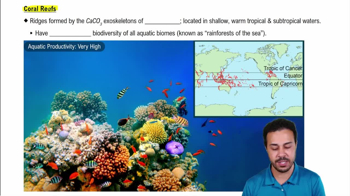Here are the essential concepts you must grasp in order to answer the question correctly.
Biomes
Biomes are large ecological areas on the Earth's surface, characterized by specific climate conditions, flora, and fauna. They are classified based on factors such as temperature, precipitation, and the types of organisms that inhabit them. Understanding biomes is essential for recognizing the diverse ecosystems and their interactions within the environment.
Recommended video:
Introduction to Aquatic Biomes
Coral Reefs
Coral reefs are underwater structures made primarily of calcium carbonate, which is secreted by coral polyps, the dominant organisms in these ecosystems. They are known for their biodiversity and play a crucial role in marine life, providing habitat and food for various species. The health of coral reefs is vital for maintaining the balance of marine ecosystems.
Recommended video:
Mineral Deposits
Mineral deposits refer to the accumulation of minerals that can form through biological processes, such as the secretion of calcium carbonate by organisms like corals. These deposits contribute to the structural integrity of certain biomes, particularly coral reefs, and are essential for understanding the geological and ecological dynamics of these environments.
Recommended video:



